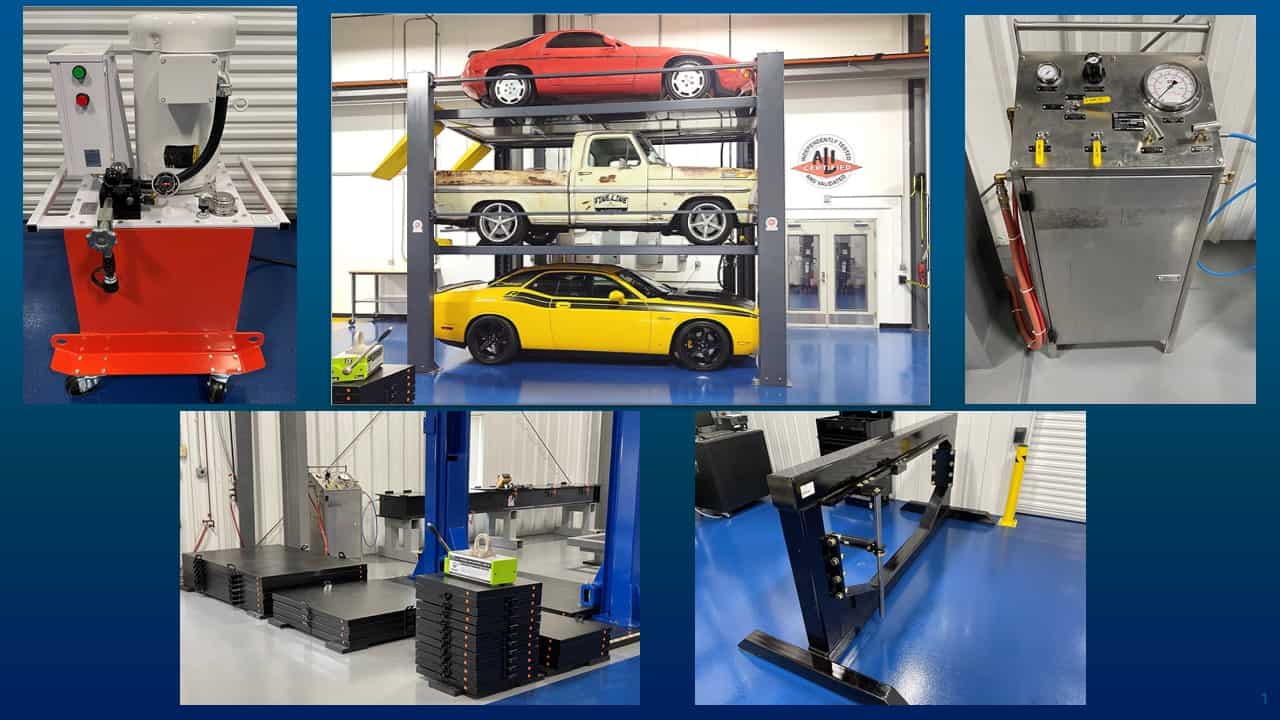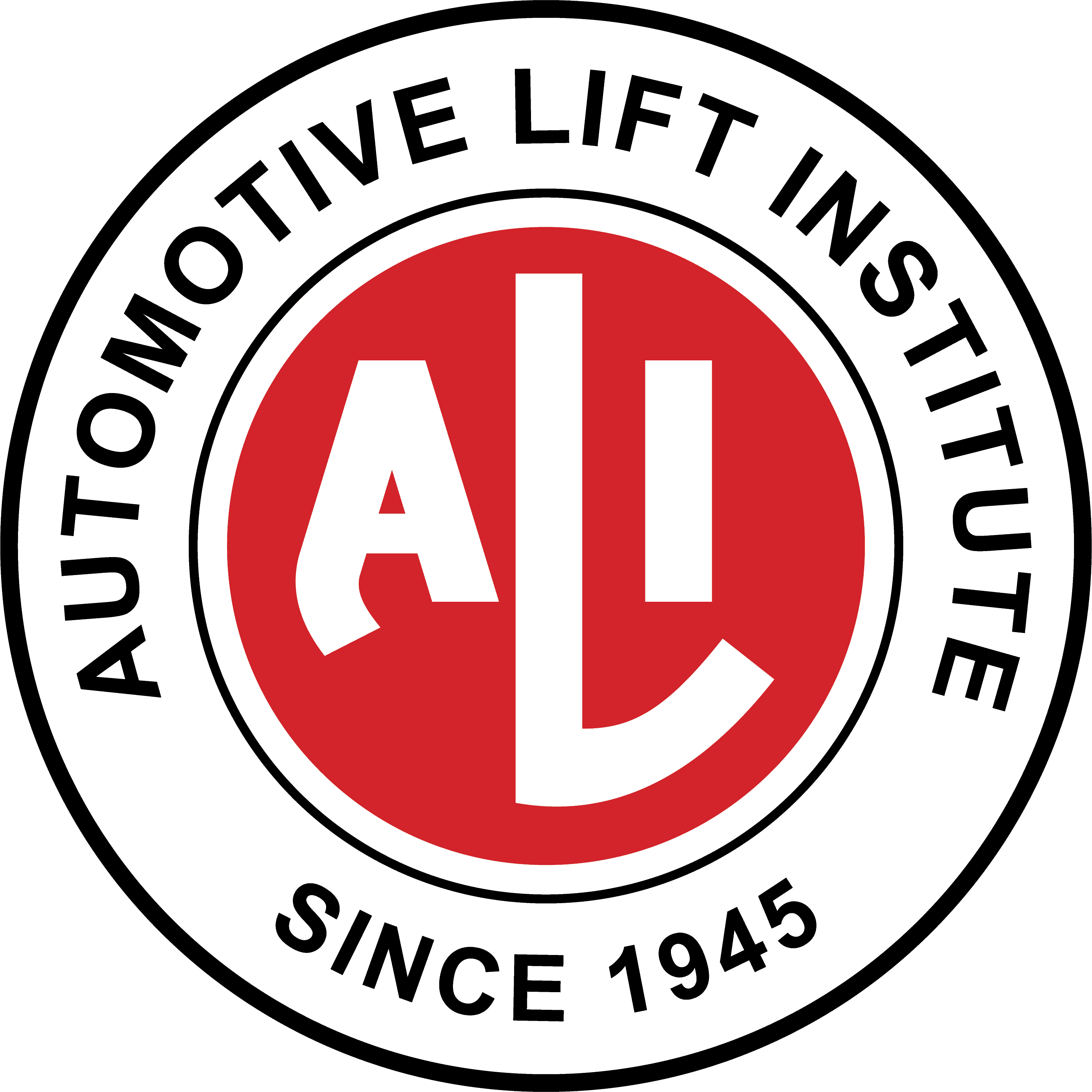ALI History Timeline

ALI History Timeline
– Download Full ALI History Timeline Return to History
1945
1945
1947
1948
1958
1960s
1962
1965
1970
1973
1974
1974
1975
1975
1981
1983
1987
1987
1988
1990
1990
1991
1992
1993
1994
1997
1998
2000
2001
2001
2005
2006
2006
2006
2007
2008
2009
2011
2011
2012
2012
2012
2013
2013
2014
2014
2015
2015
2016
2016
2017
2017
2018
2018
2018
2018
2019
2019
2020
2020
2021
ALI Founded – Organizing an Industry
In 1945, emerging from the industrial chaos of World War II, nine U.S. lift manufacturers agreed to work together for their common good under the auspices of a new trade association, and the Automotive Lift Institute (ALI) was formed.
The founding charter members were:
Curtis Pneumatic Machinery Co. Gilbert & Barker Mfg Co.
Globe Hoist Company Hayward Products Corp.
Joyce-Cridland Company Rotary Lift Company
U.S. Air Compressor Co. Wayne Pump Company
Weaver Manufacturing Co.
These companies shared concerns over the availability of steel and other raw materials used to produce automotive lifts since these materials remained under government allocation. At the same time, high-grade steel, required for machined pistons and cylinders and for forming superstructure components, was in short supply and as a result, scrap steel of questionable quality was being reprocessed to manufacture some lifts. As a result, ALI was concerned about the quality of vehicle lifts produced and the safety of the lift operator.
This focus on quality and safety continues in the forefront of ALI activities and is the foundation of our mission today.
Creating a Vision of Safety
David Laine was appointed secretary and staff head in 1945. Under his leadership, ALI developed its original activities to promote industry safety and support ALI’s nine founding members. Laine’s office was in New York City.
A Lift Design Standard: CS142-47
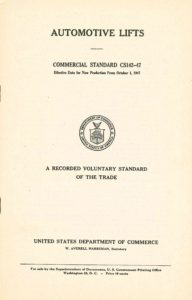 The first nationally recognized Commodity Standard governing “Automotive Lifts”, issued by our government in 1947, after two years of committee meetings and correspondence with the National Bureau of Standards, the first nationally recognized commodity standard governing automotive lifts (CS142) was issued by the U.S. Department of Commerce.
CS142 was a design standard covering the strength factors and material requirements for manufacturing in-ground lifts, as these were the only type of lift produced in the United States until the mid-1970s.
The first nationally recognized Commodity Standard governing “Automotive Lifts”, issued by our government in 1947, after two years of committee meetings and correspondence with the National Bureau of Standards, the first nationally recognized commodity standard governing automotive lifts (CS142) was issued by the U.S. Department of Commerce.
CS142 was a design standard covering the strength factors and material requirements for manufacturing in-ground lifts, as these were the only type of lift produced in the United States until the mid-1970s.Amendment to CS142-47 Standard (CS142-51)
Third Edition (CS142-58) – Superseded CS142-51
Department of Commerce Directs National Bureau of Standards to Withdraw
By the late 1960s, the U.S. Department of Commerce directed the National Bureau of Standards (NBS) to withdraw from commodity standards activities. As a result, ALI was advised by the NBS to approach the American National Standards Institute (ANSI) about the lift industry standard.
Fourth Edition (CS142-62) – Superseded CS142-58
Fifth Edition (CS142-65) – Superseded CS142-62
Developing a Lift Performance Standard
In 1971, ANSI was enthusiastically backing public sentiment which called for replacing design standards with performance standards. This meant that standards should not provide requirements for materials and manufacturing methods, but rather only state how these products should perform in service. At the same time, all industries were living in anticipation of the impending impact of the first OSHA regulations, enacted in 1974. In this environment, ALI rewrote the existing standard to address safety issues with vigor. Safety devices that previously had been optional were made mandatory for manufacturers, although some major purchasers, including oil companies, signed waivers authorizing automotive lift products to be shipped without selected safety devices.
E.K. “Chic” Fox – Redefining Industry Safety Requirements
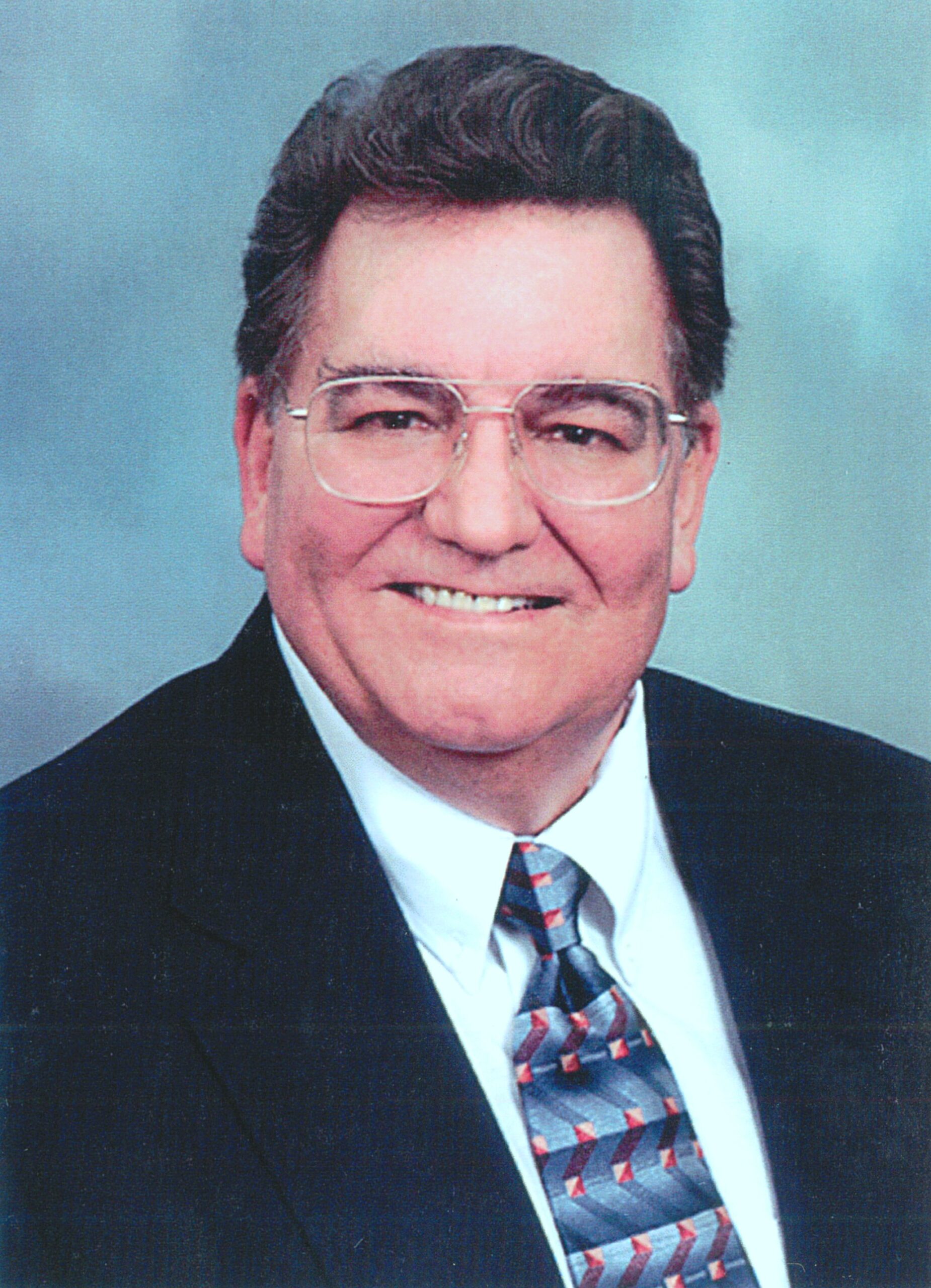 With the death of David Laine in December 1973, E.K. “Chic” Fox assumed the role of staff head until ALI’s by-laws were revised in early 1974. This revision allowed Fox to be elected as ALI’s first president. His leadership is credited with moving ALI onto the path of redefining industry safety requirements and establishing ALI as the watchdog for the automotive lift industry.
With the death of David Laine in December 1973, E.K. “Chic” Fox assumed the role of staff head until ALI’s by-laws were revised in early 1974. This revision allowed Fox to be elected as ALI’s first president. His leadership is credited with moving ALI onto the path of redefining industry safety requirements and establishing ALI as the watchdog for the automotive lift industry.
OSHA Regulations Enacted – Safety Remains ALI’s Primary Concern
When OSHA requirements became law in 1974, ALI developed a 3”x5” laminated “Operating and Maintenance Instructions” hang tag that was shipped with each new lift and was also made available as a retrofit for older lifts. In 1980, this became an 8-1/2″x 11″ “Safety Tips” glossy card that was generic to the lifts then being produced.
ANSI Issues B153.1 Performance Standard – American National Standard Safety Requirements for Construction, Care, and Use of Automotive Lifts
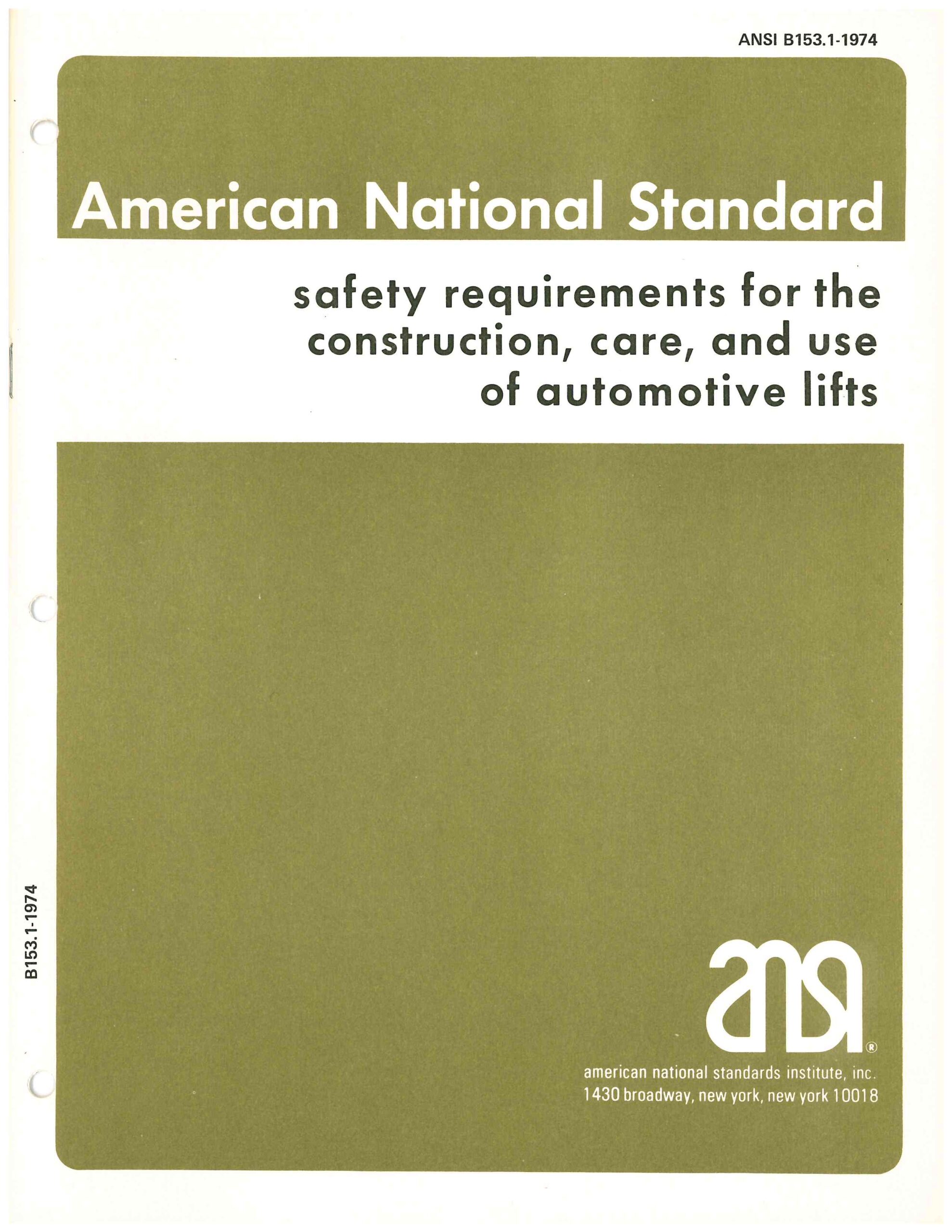 In 1974, ANSI issued the first version of ANSI B153.1. This National Standard addressed in-ground lifts, with a passing reference to screw-drive mechanisms, which at the time represented the introduction of surface-mounted lifts in the United States.
Although a new standard, many sections of it are revisions of National Bureau of Standards Commercial Standard CS142-65, Automotive Lifts, which is the 1965 edition of a voluntary standard of the trade, covering lift design requirements.
As the National Bureau of Standards subsequently restricted its activity in the area of commodity standards, it recommended that the Automotive Lift Institute submit its proposed revision of CS142-65 to the American National Standards Institute for approval as an American National Standard. After provisions designed to improve safety in the operation of automotive lifts were added to the basic construction standard (CS142-65) by the ALI Engineering Committee, the document was submitted to the Standards Institute.
In 1974, ANSI issued the first version of ANSI B153.1. This National Standard addressed in-ground lifts, with a passing reference to screw-drive mechanisms, which at the time represented the introduction of surface-mounted lifts in the United States.
Although a new standard, many sections of it are revisions of National Bureau of Standards Commercial Standard CS142-65, Automotive Lifts, which is the 1965 edition of a voluntary standard of the trade, covering lift design requirements.
As the National Bureau of Standards subsequently restricted its activity in the area of commodity standards, it recommended that the Automotive Lift Institute submit its proposed revision of CS142-65 to the American National Standards Institute for approval as an American National Standard. After provisions designed to improve safety in the operation of automotive lifts were added to the basic construction standard (CS142-65) by the ALI Engineering Committee, the document was submitted to the Standards Institute.In-Ground Lifts Dominate into the Mid ’70s
As a result of these market forces, lift sales dropped 65 percent between 1969 and 1975, and nearly half of U.S. lift manufacturers failed or merged. ALI was facing financial extinction. However, at the same time, a new concept in lifts was taking a foothold in the U.S. marketplace. By 1975 about 10 percent of new lift sales in the now depressed market were comprised of surface-mounted lifts. Many of these lifts came from overseas, some were manufactured by ALI members and a few non-member companies were initiating production of these “new” style lifts.
ALI adopted a revised constitution and by-laws in 1973, with further revisions in 1975 to open what previously had been an “in-ground” lift manufacturers association to allow domestic producers of surface-mounted lifts and national marketers of foreign lifts (affiliates) to become members.
Meanwhile, vehicle design was changing. Cars previously assembled onto underbody frames were now adopting unibody and other frameless designs. For years, all major domestic and foreign automobile manufacturers replied to ALI’s annual surveys requesting the car manufacturers to furnish ALI with their recommended pick-up points so that, in turn, lift manufacturers could supply lift owners with the necessary adapters that would reach those points and offer safety to lift operators. With the advent of the “frameless” car designs, ALI no longer benefited from their input, and ALI’s annual survey was discontinued.
CS142.68 Officially Withdrawn
The original 1947 CS142 design standard was revised several times before being officially withdrawn by the National Bureau of Standards in 1975. The standard was replaced by ANSI B153.1-1974.
ANSI B153.1-1981 replaced the 1974 edition
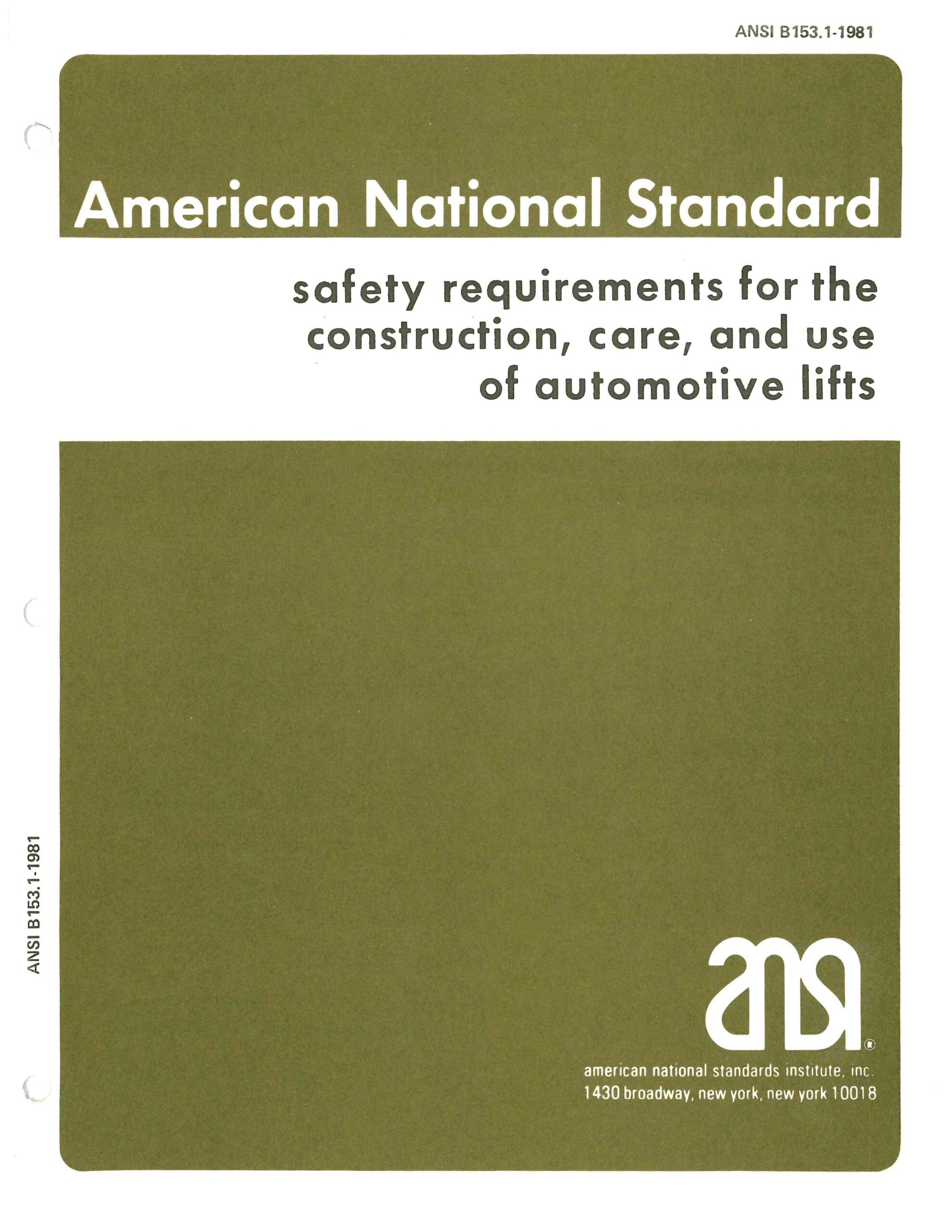
ALI Membership Welcomes Canadian Manufacturers
The ALI Constitution and By-Laws were rewritten in 1983 to accept Canadian lift producers as manufacturing members. In addition, the first membership initiation fee was introduced.
Lifting It Right – Safety Manual Development
In the mid-1980s, ALI developed the Lifting it Right Safety Manual. A special assessment of the 17 members was required to typeset and produce the first edition. This assessment was a big step considering that ALI’s annual revenue up to this point had been minimal. Since this time, more than 4 million copies of this Safety Manual have been distributed by members or sold to the public.
ALI Relocates to Florida
Under the continued leadership of ALI President E.K. “Chic” Fox, ALI’s offices relocated from New York City to Indialantic, FL.
ALI Membership and the Industry Grow
Lift sales escalated during the early 1980s, and the number of lift manufacturers and lift designs were at an all-time high. By 1988, ALI had 17 member companies representing approximately 80 percent of the domestic market. There were also some 30 non-member companies that were marketing lifts in North America.
Development of SAE J2184
Although ALI had discontinued its annual survey of OEMs, lift manufacturers and technicians using lifts still needed lifting point information for all vehicles. This information is especially important when using the surface-mounted swing-arm type lifts that had become the best-selling lift style by 1990. In late 1990, ALI convinced the Society of Automotive Engineers (SAE) to develop an SAE Recommended Practice for permanent undercar identification of lift points and for on-car lifting point labeling to be phased in as body styles change.
This resulted in SAE J2184 being promulgated in late 1992. This SAE Recommended Practice was adopted by ANSI as an American National Standard, and as some auto manufacturers implemented the requirements into new model years, it was expected this practice would help prevent accidents involving swing-arm type lifts.
ANSI/ALI B153.1-1990 replaced the 1981 edition
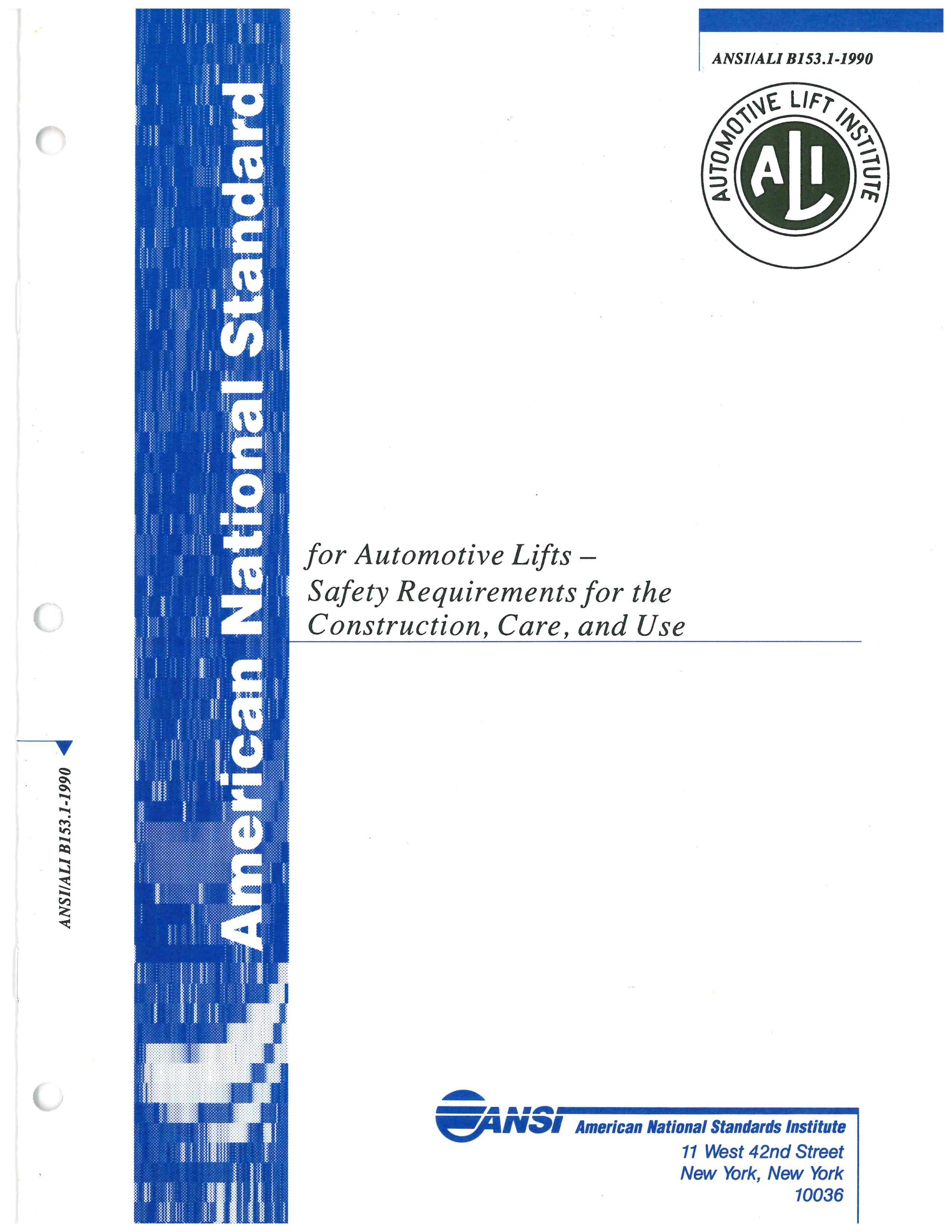
Initial Production of ALI’s Uniform Warning Labels
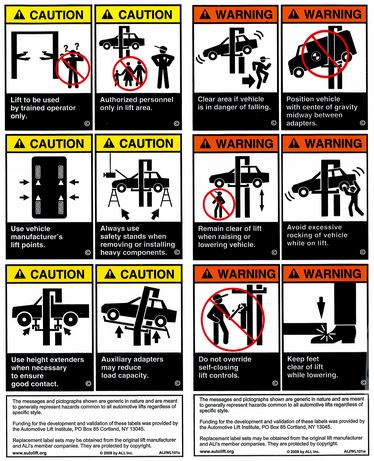 In a proactive initiative to further ALI’s industry safety proposition, ALI’s Member Companies recognized the need to identify vehicle lift related hazards and to warn against them. This resulted in several years of research and development activities to bring ALI’s “Uniform Safety Warning Labels” to fruition.
The development and validation work supporting this project was contracted by ALI to the National Safety Council and the University of Michigan’s Transportation Research Institute. In 1991, a special assessment of the members was needed to fund the contracted work and the initial production cost.
The messages and pictographs of ALI’s warning labels are generic in nature and are meant to generally represent common automotive lift hazards. These labels and placards come in kits representing 7 different lift types. Their use, or equivalent labeling, is now required on certified lifts. In fact, it has become an industry “best practice” to apply ALI’s safety warning labels regardless of the lift manufacturer’s membership status or the lift’s certification status.
In a proactive initiative to further ALI’s industry safety proposition, ALI’s Member Companies recognized the need to identify vehicle lift related hazards and to warn against them. This resulted in several years of research and development activities to bring ALI’s “Uniform Safety Warning Labels” to fruition.
The development and validation work supporting this project was contracted by ALI to the National Safety Council and the University of Michigan’s Transportation Research Institute. In 1991, a special assessment of the members was needed to fund the contracted work and the initial production cost.
The messages and pictographs of ALI’s warning labels are generic in nature and are meant to generally represent common automotive lift hazards. These labels and placards come in kits representing 7 different lift types. Their use, or equivalent labeling, is now required on certified lifts. In fact, it has become an industry “best practice” to apply ALI’s safety warning labels regardless of the lift manufacturer’s membership status or the lift’s certification status.Third-Party Testing – A Requirement for Membership
By the early 1990s, approximately 50 companies were marketing lifts in North America and private testing showed that an increasing number of lifts failed to meet the standards they claimed through self-certification. Some manufacturers were also not supplying the printed safety materials and appropriate warning labels/placards required to be included with all new lifts.
After many months of discussion, ALI concluded that the most effective way to address the false claims of conformity was to institute independent third-party testing and certification for automotive lifts, eliminating the ability for manufacturers to self-certify. ALI members agreed to accept the substantial cost of testing their products as the right thing to do to promote safety for lift users. Members agreed to pledge to absorb the cost of certifying at least 75 percent of their products as a condition of continuing ALI membership. The ALI Automotive Lift Certification Program was born.
Today, both current and prospective ALI members must certify at least 75 percent of their lifts through the program. Although it is encouraged, ALI membership is not required to participate in the ALI Lift Certification Program.
ALI entered into an agreement in February 1992 accepting Edison Testing Laboratories (ETL) — now known as Intertek Testing Laboratories — of Cortland, New York, as its third-party certification program administrator and primary authorized testing laboratory. Intertek is a Nationally Recognized Testing Laboratory (NRTL) accredited by OSHA. MET Laboratories was introduced in March 2000 as a second authorized NRTL accredited by OSHA. TUV Peabody became the third NRTL accredited by OSHA to be approved by ALI as an authorized testing laboratory in 2013.
Lifting It Right Safety Video
A 17-minute VHS video was created to serve as a companion to the “Lifting it Right” Safety Manual. Development took more than two years. It was issued in mid-1993.
ANSI/ALI ALOIM – American National Standard for Automotive Lifts – Safety Requirements for Operation, Inspection and Maintenance
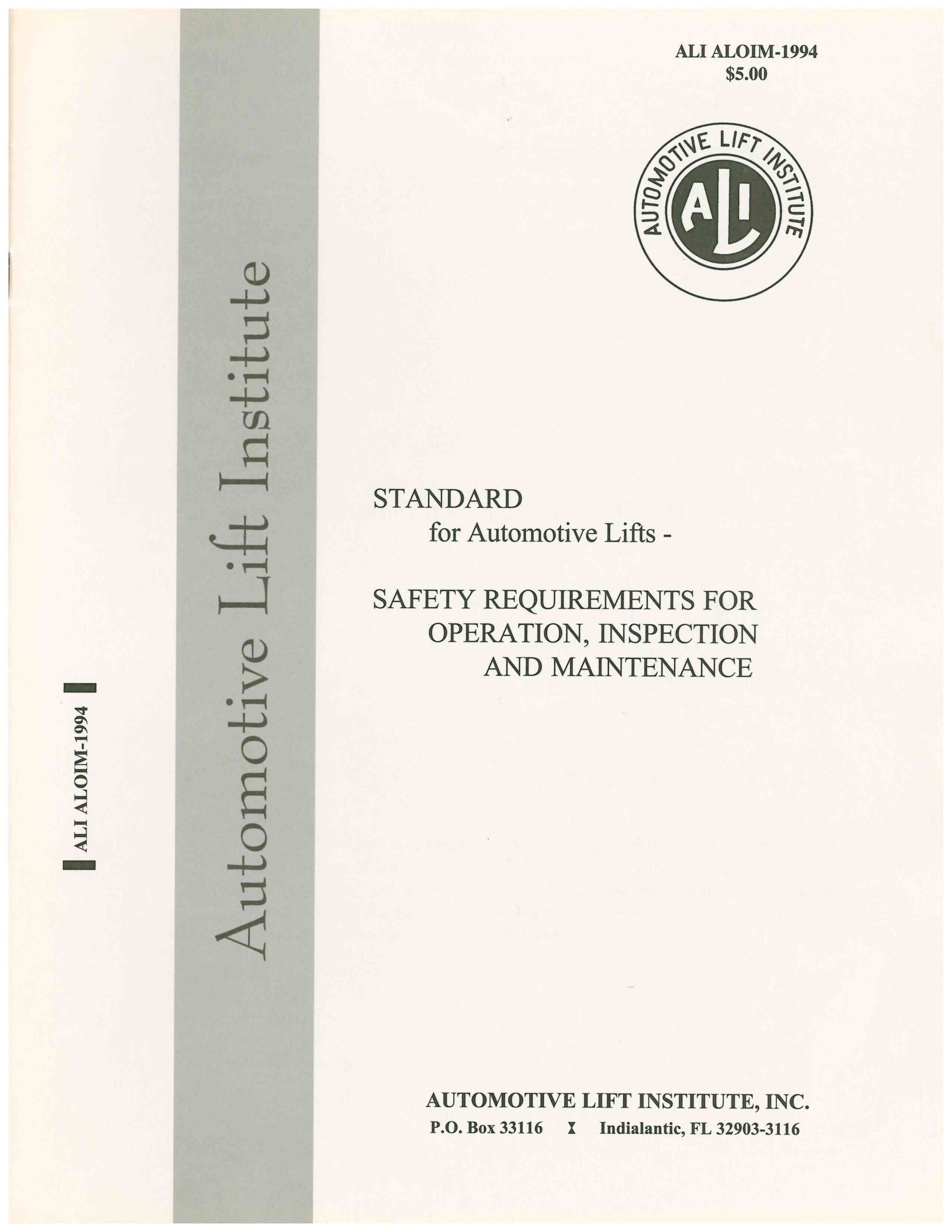 Developed as a companion standard expanding the requirements previously embraced by ANSI/ALI B153.1 pertaining to the responsibilities of the owners of automotive lifts and/or the employers of personnel who use the automotive lifts.
The ALI Engineering Committee (which was reorganized with an expanded scope in 2005 as the Safety and Standards Technical Committee) developed the first industry standard addressing “Safety Requirements for the Operation, Inspection, and Maintenance of Automotive Lifts”. This ALOIM Standard was first adopted as an ANSI national safety standard in August 1996, and was revised and approved again as an American National Standard in 2000 and 2008. In 2013, the 2008 ALOIM Standard was reaffirmed by ANSI.
Developed as a companion standard expanding the requirements previously embraced by ANSI/ALI B153.1 pertaining to the responsibilities of the owners of automotive lifts and/or the employers of personnel who use the automotive lifts.
The ALI Engineering Committee (which was reorganized with an expanded scope in 2005 as the Safety and Standards Technical Committee) developed the first industry standard addressing “Safety Requirements for the Operation, Inspection, and Maintenance of Automotive Lifts”. This ALOIM Standard was first adopted as an ANSI national safety standard in August 1996, and was revised and approved again as an American National Standard in 2000 and 2008. In 2013, the 2008 ALOIM Standard was reaffirmed by ANSI.ALI began annual publication of the “Vehicle Lifting Points/Quick Reference Guide” for frame-engaging lifts covering domestic and imported cars and light trucks.
ANSI/ALI ALCTV – American National Standard for Automotive Lifts – Safety Requirements for Construction, Testing and Validation; Third-Party Testing and Product Safety Certification Becomes an Industry Requirement
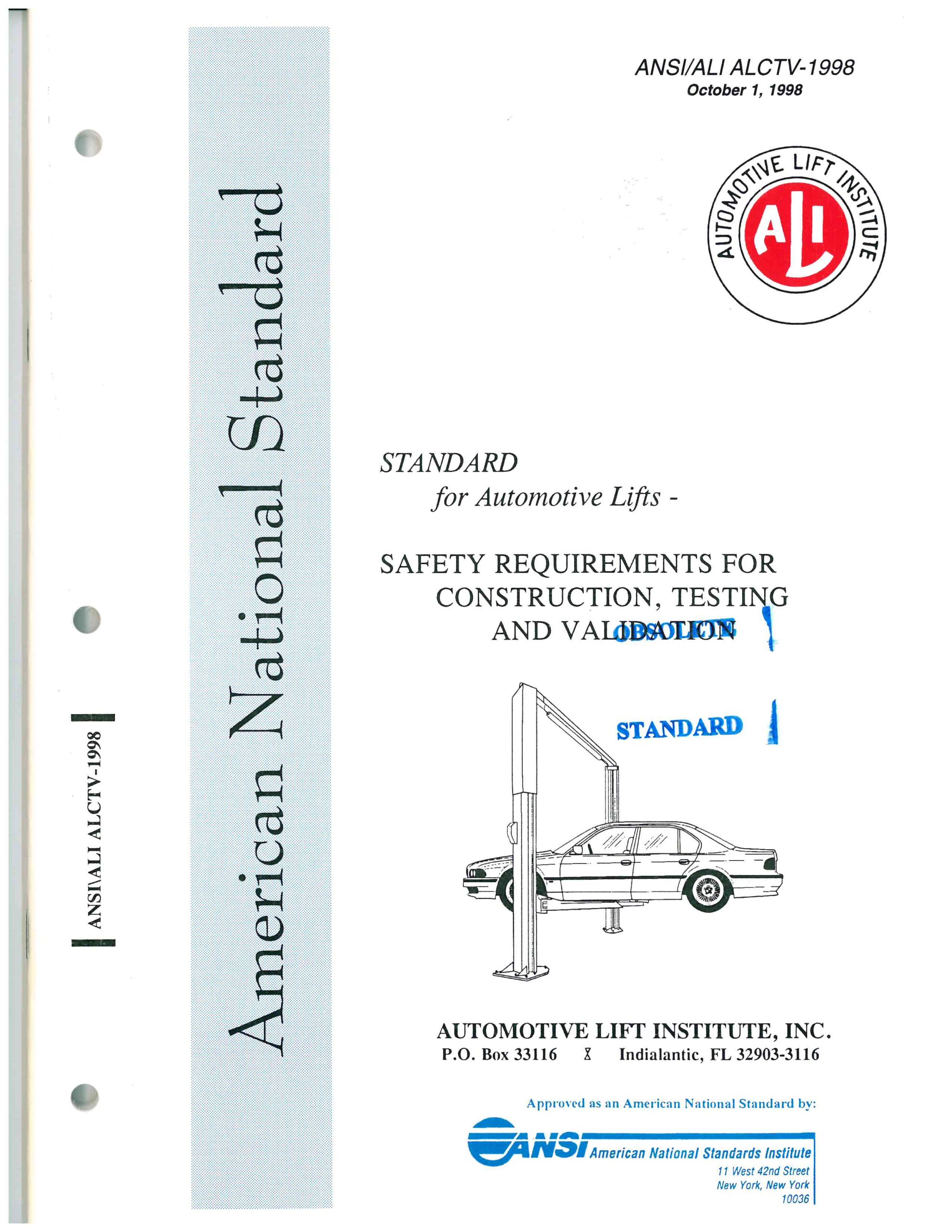 The 1974 version of the ANSI B-153.1 standard went through revisions in 1981 and 1990. On Oct. 1, 1998, ANSI/ALI ALCTV-1998, “Safety Requirements for the Construction, Testing and Validation of Automotive Lifts” was adopted as the new nationally recognized consensus standard for the lift industry replacing ANSI B-153.1. The ANSI/ALI ALCTV standard became fully effective in April 2000.
Of significant importance in this new standard was the requirement for independent, third-party product testing and certification. The 1998 version of this American National Standard was withdrawn on Nov. 4, 2007 and replaced by American National Standard ANSI/ALI ALCTV-2006. On June 20, 2013, ALCTV-2011 went into effect. It was itself replaced by ANSI/ALI ALCTV-2017, which was approved by ANSI on Jan. 24, 2017, and took effect July 24, 2018. This version of the standard reflects significant updates to the testing that must be performed by an NRTL to confirm that a lift meets the requirements outlined in the standard.
The 1974 version of the ANSI B-153.1 standard went through revisions in 1981 and 1990. On Oct. 1, 1998, ANSI/ALI ALCTV-1998, “Safety Requirements for the Construction, Testing and Validation of Automotive Lifts” was adopted as the new nationally recognized consensus standard for the lift industry replacing ANSI B-153.1. The ANSI/ALI ALCTV standard became fully effective in April 2000.
Of significant importance in this new standard was the requirement for independent, third-party product testing and certification. The 1998 version of this American National Standard was withdrawn on Nov. 4, 2007 and replaced by American National Standard ANSI/ALI ALCTV-2006. On June 20, 2013, ALCTV-2011 went into effect. It was itself replaced by ANSI/ALI ALCTV-2017, which was approved by ANSI on Jan. 24, 2017, and took effect July 24, 2018. This version of the standard reflects significant updates to the testing that must be performed by an NRTL to confirm that a lift meets the requirements outlined in the standard.

ANSI/ALI ALOIM – 2000 replaced the ALOIM-1994
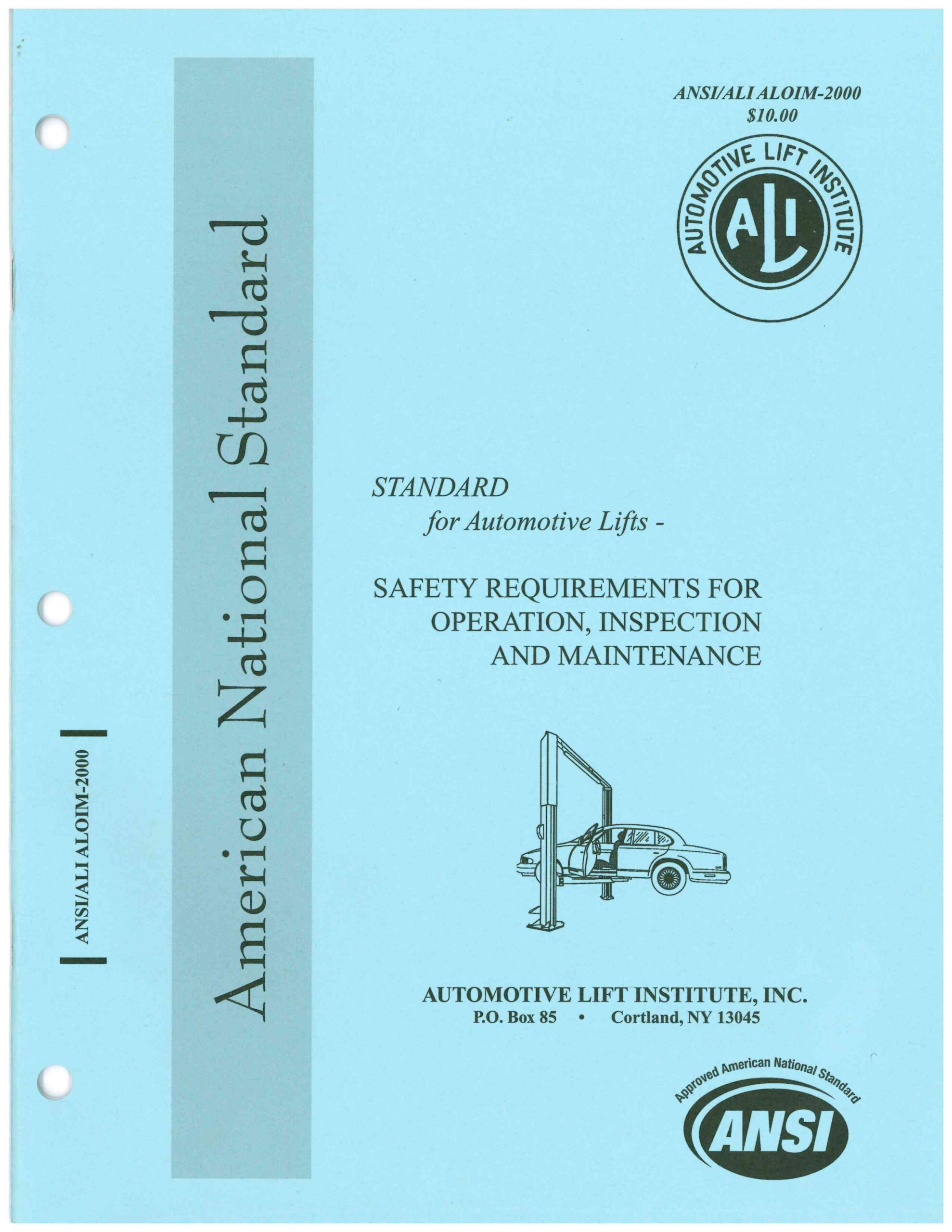
Lift Certification Program Receives ANSI Accreditation
The ALI Lift Certification Program received initial American National Standard Institute (ANSI) accreditation in November 2001. ANSI’s accreditation program was established to provide government and industry with a high level of confidence in the integrity of third-party product certification programs. After a program has been accredited, continued conformance with program qualification requirements is verified by ANSI auditors through annual on-site and factory assessments.
This approach provides the lift purchaser or bid specifier with a high level of confidence, which allows for informed decisions to be made regarding the status of product compliance with the current national safety and performance standards. This approach significantly reduces risk and provides a guarantee that the listed product has been assessed by a competent, independent body, therefore inspiring confidence in the product and trust in ALI’s Certification Mark.
The ALI Automotive Lift Certification Program is guided by a detailed procedural guide. This guide describes the program and addresses general administrative matters, as well as other important requirements designed to assist participants by assuring that their listed products fully comply with the requirements of the current editions of applicable American National Standards.
The program is described in National Institute of Standards and Technology (NIST) publication SP903. For a manufacturer to initiate evaluation of an automotive or vehicle lift, a multi-party program participation agreement that sets out the responsibilities of each party must be signed by the participant, the program administrator, and the program sponsor (ALI). Should manufacturing occur at a location other than the participant’s primary facility, the authorized production facility (APF) must also be party to the agreement. ALI’s certification program offers testing and qualification for listing of any type of automotive or vehicle lift covered within the scope of ANSI/ALI ALCTV (current edition).
ANSI/ALI ALIS Approved as an American National Standard for Automotive Lifts – Safety Requirements for Installation and Service
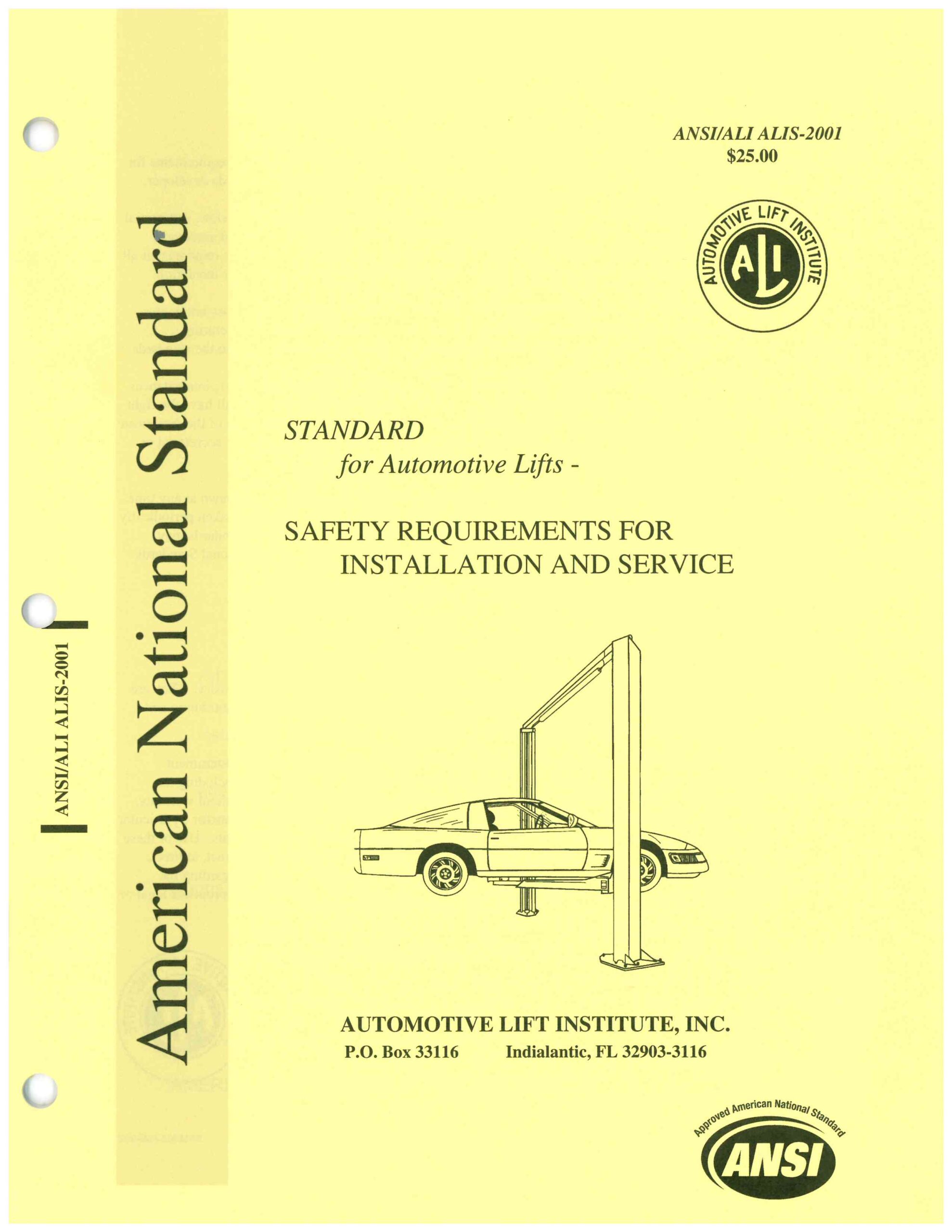 Another important safety standard for the automotive lift industry, ANSI/ALI ALIS entitled “Safety Requirements for the Installation and Service of Automotive Lifts, ” was initially approved as an American National Standard in October 2001. The standard was revised in 2009.
This standard provides guidance to the installer and lift service technician for the installation and service of automotive lifts, including the required qualifications, training, reporting and documentation for installers and service personnel.
Another important safety standard for the automotive lift industry, ANSI/ALI ALIS entitled “Safety Requirements for the Installation and Service of Automotive Lifts, ” was initially approved as an American National Standard in October 2001. The standard was revised in 2009.
This standard provides guidance to the installer and lift service technician for the installation and service of automotive lifts, including the required qualifications, training, reporting and documentation for installers and service personnel.New President Appointed
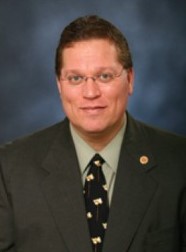 With the retirement of Chic Fox in April 2005, R.W. “Bob” O’Gorman was appointed as ALI president and CEO. Within his first year, the association’s offices were relocated from Indialantic, FL to Cortland, NY. In the years to follow, a path of continual process improvement would lead to other changes including: revision of the Constitution and By-Laws, expansion of the Institute’s safety focus, the addition of full-time technical staff to better support the membership and ALI’s growing safety message, development of ALI’s online safety course for lift operators, and launching ALI ‘s Inspector Certification Program .
With the retirement of Chic Fox in April 2005, R.W. “Bob” O’Gorman was appointed as ALI president and CEO. Within his first year, the association’s offices were relocated from Indialantic, FL to Cortland, NY. In the years to follow, a path of continual process improvement would lead to other changes including: revision of the Constitution and By-Laws, expansion of the Institute’s safety focus, the addition of full-time technical staff to better support the membership and ALI’s growing safety message, development of ALI’s online safety course for lift operators, and launching ALI ‘s Inspector Certification Program .Uniform Warning Labels – French, Spanish, and Mandarin
In 2006, in response to increasing interest from industry, ALI made its Uniform Warning Label kits available in Canadian French, neutral Spanish and Mandarin.
National Safety Council Endorses Lifting It Right Safety Video
In 2006, with more than 10,000 copies of the VHS video distributed, the popular training tool was updated and issued on DVD. The new program was hosted by NASCAR racing legends Richard and Kyle Petty and endorsed by the National Safety Council. The program was sold as a kit that included the DVD, a reproducible written test, instructor’s answer key and user guide, and copies of the Lifting It Right Safety Manual and Safety Tips Card.
ANSI/ALI ALCTV 2006 replaced the ALCTV – 1998
 (New standard effective November 4, 2007)
(New standard effective November 4, 2007)
International Acceptance and Compliance
By 2007, many of ALI’s safety efforts had been recognized globally. WorkSafe BC, Ontario’s Ministry of Labour, and other provincial health and safety organizations throughout Canada have incorporated ALI-sponsored national standards and/or third-party certification requirements into their regulations or practices. The Saudi Arabian Standards Association (SASA) had also adopted ANSI/ALI ALCTV, as a requirement.
In the United States, many authorities having jurisdiction (AHJ), such as building code officials and bid specifiers, had made compliance with ALCTV and ALOIM compulsory. Other AHJs, such as those involved in occupational safety and health, accepted compliance with ALI-sponsored standards and the use of ALI safety materials to abate penalty-based findings related to life safety and hazards in the workplace.
ANSI/ALI ALOIM 2008 replaced the ALOIM 2000

ANSI/ALI ALIS 2009 replaced the ALIS 2001
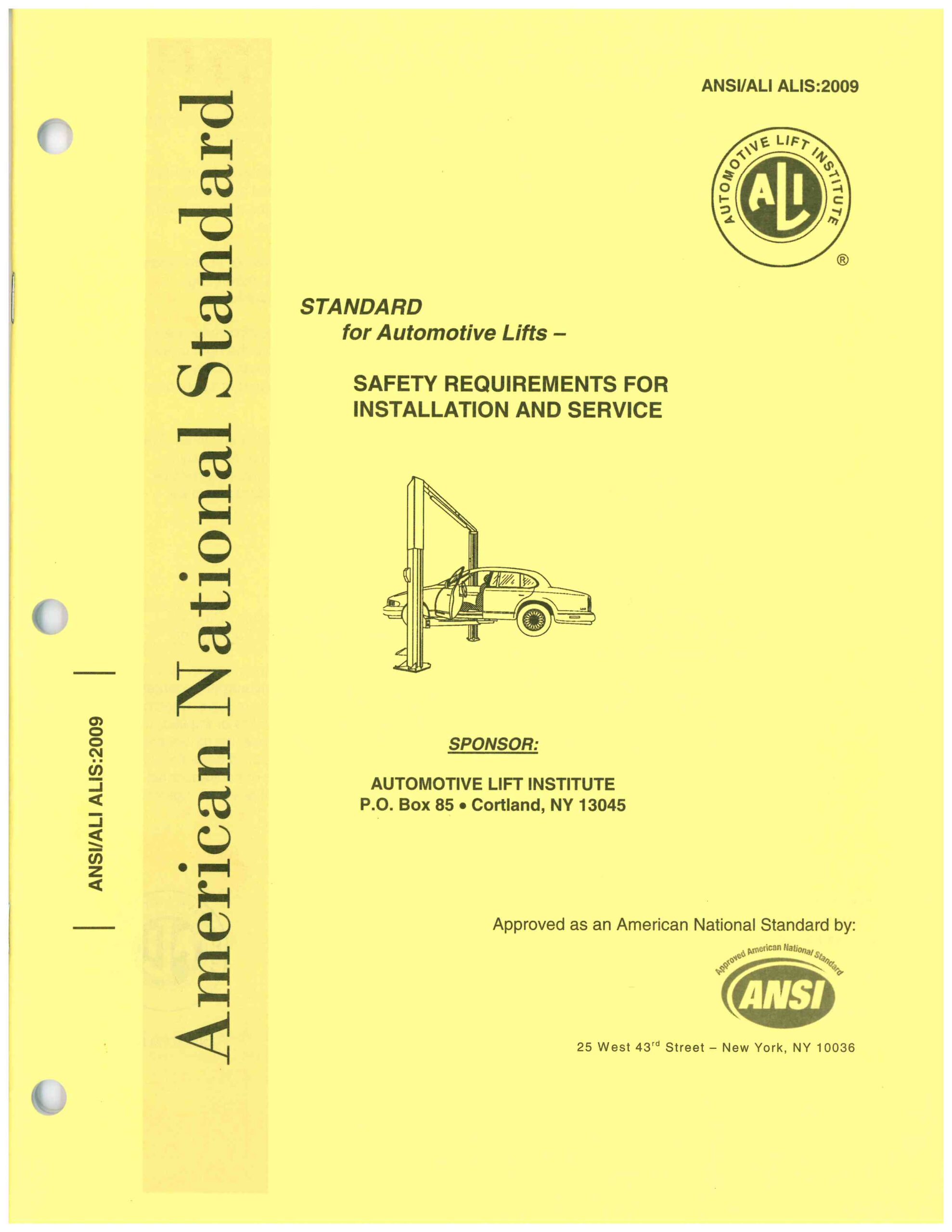
ANSI/ALI ALCTV 2011 replaced the ALCTV – 2006; Understanding Electrical and Mechanical Safety Requirements
https://www.autolift.org/wp-content/uploads/2024/06/ALCTV1998_001-scaled.jpg
An increase in penalty-based initiatives by various health and safety and building code officials throughout the U.S. and each of the Canadian provinces highlighted the need to better educate purchasers, shop owners, supervisors, and end users such as mechanics, technicians, students, and DIY hobbyists and collectors about the requirements of ALCTV for their own safety as work on the next version of the standard began in early 2011.
As the work to develop this edition began in early 2011, ALI activities included educating stakeholders and authorities having jurisdiction (AHJ) about product safety compliance. Much of this education focused on the need for electrical and mechanical safety listing by a third-party certification agency and an awareness campaign highlighting the fact that all prior editions of ANSI/ALI ALCTV and ANSI/ALI B153.1 would no longer be recognized as American National Standards when a newer edition becomes effective.
ALI Sponsors Petty’s Garage Car Show
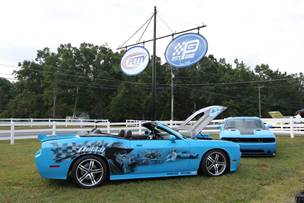 ALI sponsored the inaugural Petty’s Garage Spring Fling Car Show held at Richard Petty’s custom hot rod shop in Level Cross, N.C., on May 28, 2011. The car show was the setting for the unveiling of Legacy by Petty, a one-of-a-kind Dodge Challenger custom built by Petty’s Garage to pay tribute to Richard Petty and promote vehicle lift safety.
ALI presented the car show for the next five years. The event, held in October since 2014, takes place on what is now the Petty Historical Site, home of both Petty’s Garage and the Richard Petty Museum. This campus in Level Cross, N.C., includes the house where Richard and Maurice Petty were born and raised, as well as the original Petty Race Shop. Proceeds from the car show benefit the Petty Family Foundation.
ALI sponsored the inaugural Petty’s Garage Spring Fling Car Show held at Richard Petty’s custom hot rod shop in Level Cross, N.C., on May 28, 2011. The car show was the setting for the unveiling of Legacy by Petty, a one-of-a-kind Dodge Challenger custom built by Petty’s Garage to pay tribute to Richard Petty and promote vehicle lift safety.
ALI presented the car show for the next five years. The event, held in October since 2014, takes place on what is now the Petty Historical Site, home of both Petty’s Garage and the Richard Petty Museum. This campus in Level Cross, N.C., includes the house where Richard and Maurice Petty were born and raised, as well as the original Petty Race Shop. Proceeds from the car show benefit the Petty Family Foundation.ALI Certifies Lift Inspectors and Launches New Online Directory
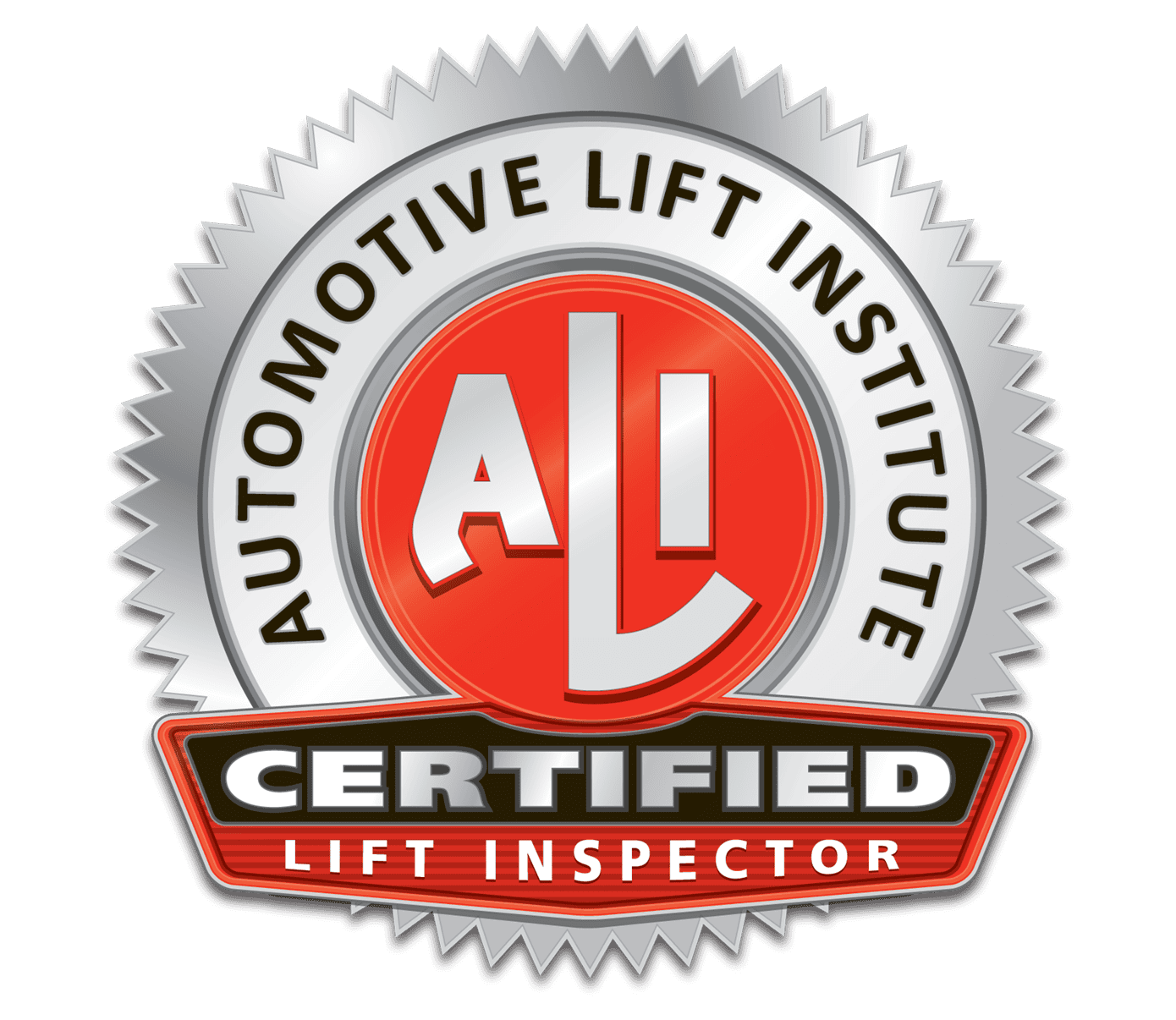 The ANSI/ALI ALOIM standard mandates that all installed vehicle lifts be inspected at least annually by a “qualified lift inspector.” The standard also provides some guidance on what qualifications the inspector should have, however, there was no national resource for finding qualified inspectors. In this buyer-beware environment, the best option lift owners had was to get recommendations from the manufacturers of their lifts.
In October 2012, after several years of development and a financial investment of more than $700,000, ALI launched the pilot program for the first third-party lift inspector certification program. This represented the final milestone to validate program operation in the field prior to accreditation. The ALI Lift Inspector Certification Program now provides third-party qualification of vehicle lift inspectors and certifies those who demonstrate they are capable of properly inspecting vehicle lifts in accordance with the ANSI standard governing vehicle lift inspection.
In 2013, ALI introduced an online directory to help lift owners find service providers with at least one ALI Certified Lift Inspector on staff.
The ANSI/ALI ALOIM standard mandates that all installed vehicle lifts be inspected at least annually by a “qualified lift inspector.” The standard also provides some guidance on what qualifications the inspector should have, however, there was no national resource for finding qualified inspectors. In this buyer-beware environment, the best option lift owners had was to get recommendations from the manufacturers of their lifts.
In October 2012, after several years of development and a financial investment of more than $700,000, ALI launched the pilot program for the first third-party lift inspector certification program. This represented the final milestone to validate program operation in the field prior to accreditation. The ALI Lift Inspector Certification Program now provides third-party qualification of vehicle lift inspectors and certifies those who demonstrate they are capable of properly inspecting vehicle lifts in accordance with the ANSI standard governing vehicle lift inspection.
In 2013, ALI introduced an online directory to help lift owners find service providers with at least one ALI Certified Lift Inspector on staff.On Tour with Petty’s Garage
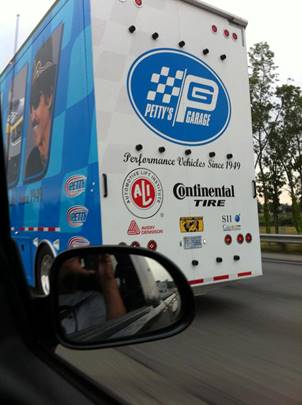 When Richard “The King” Petty decided to bring the experience of Petty’s Garage directly to fans with a nationwide tour, ALI came on board as a sponsor of the inaugural Petty’s Garage Performance Tour. The tour featured some of the unique vehicles produced by Petty’s Garage, including The King’s personal #001 Signature Series Dodge Challenger and the Legacy by Petty custom Challenger designed to honor the Petty legacy and promote vehicle lift safety.
The custom car hauler prominently featured the ALI logo and the ALI Lift Inspector Certification Program logo, helping to build awareness of the organization and its new inspection program.
Car enthusiasts visiting the Petty’s Garage trailer at car shows around the country could learn more by watching a new lift safety video featuring Petty that was shot in Petty’s Garage.
When Richard “The King” Petty decided to bring the experience of Petty’s Garage directly to fans with a nationwide tour, ALI came on board as a sponsor of the inaugural Petty’s Garage Performance Tour. The tour featured some of the unique vehicles produced by Petty’s Garage, including The King’s personal #001 Signature Series Dodge Challenger and the Legacy by Petty custom Challenger designed to honor the Petty legacy and promote vehicle lift safety.
The custom car hauler prominently featured the ALI logo and the ALI Lift Inspector Certification Program logo, helping to build awareness of the organization and its new inspection program.
Car enthusiasts visiting the Petty’s Garage trailer at car shows around the country could learn more by watching a new lift safety video featuring Petty that was shot in Petty’s Garage.Storied No. 43 Carries Lift Safety Message at NASCAR Race
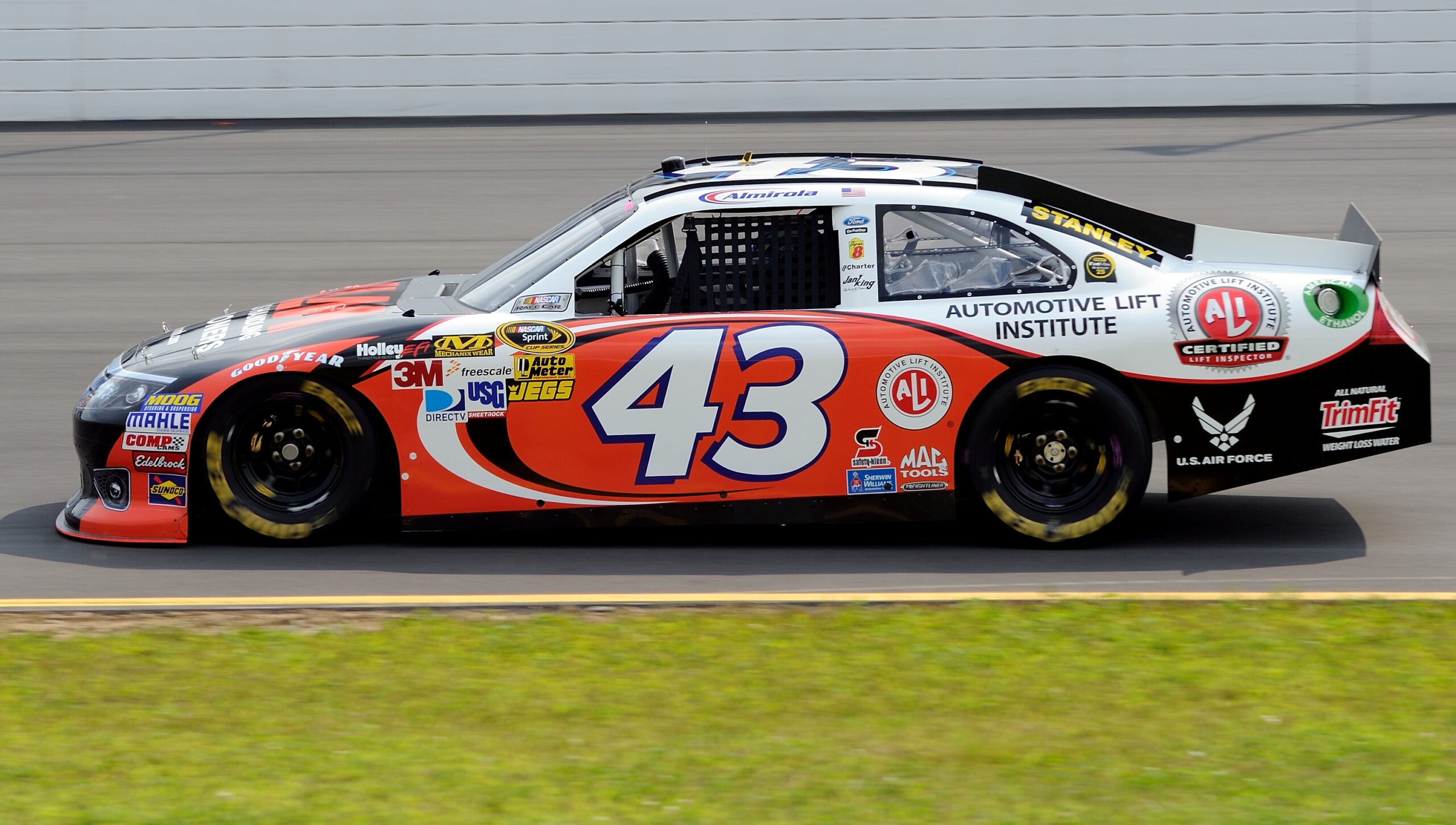 ALI was the primary partner on the Richard Petty Motorsports No. 43 Ford Fusion driven by Aric Almirola in the NASCAR Sprint Cup Series Pennsylvania 400 at Pocono Raceway on Aug. 5, 2012.
The sponsorship provided a unique platform to share ALI’s vehicle service lift safety message with millions of NASCAR fans as the institute prepared to launch the ALI Lift Inspector Certification Program.
The Automotive Lift Institute No. 43 Ford wore a paint scheme of red, white and black, with accents of Petty Blue. The ALI Certified Lift Inspector logo was prominently displayed on both quarters, with the TV panel on the rear dedicated to the ALI tagline “Your safety is riding on it.”
Lionel Racing later created a 1:24 scale diecast model of the car. The edition was limited to 535 cars.
ALI was the primary partner on the Richard Petty Motorsports No. 43 Ford Fusion driven by Aric Almirola in the NASCAR Sprint Cup Series Pennsylvania 400 at Pocono Raceway on Aug. 5, 2012.
The sponsorship provided a unique platform to share ALI’s vehicle service lift safety message with millions of NASCAR fans as the institute prepared to launch the ALI Lift Inspector Certification Program.
The Automotive Lift Institute No. 43 Ford wore a paint scheme of red, white and black, with accents of Petty Blue. The ALI Certified Lift Inspector logo was prominently displayed on both quarters, with the TV panel on the rear dedicated to the ALI tagline “Your safety is riding on it.”
Lionel Racing later created a 1:24 scale diecast model of the car. The edition was limited to 535 cars.Membership Expands to Include an Associate Class
In 2013, ALI added an Associate Class of membership to what had historically been an organization representing only lift manufacturers. Any North American operation with at least one ALI Certified Lift Inspector on staff is welcome to join as an Associate Class Member. Membership provides access to exclusive industry resources, training materials and discounts. Members also vote to put forth an Associate Class member to the ALI Board of Directors. The first Associate Class representative joined the Board in 2014.
Associate class members and non-member participants in ALI’s Lift Inspector Certification Program provide an equally critical level of confidence to industry stake holders. While this is achieved in the service bay through demonstrating compliance with the lift manufacturer’s inspection requirements and those found within ANSI/ALI ALOIM current edition, it is the Associate Class Membership and their ability to network and be represented at all Institute meetings and functions that will more positively impact industry safety.
ANSI/ALI ALOIM 2008 edition was reaffirmed and introduced to the industry as the ALOIM 2008 (R2013) Standard

Lifting It Right – Online Certificate Course
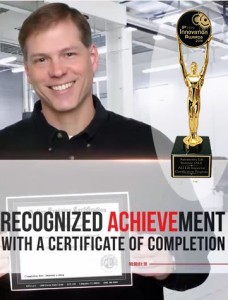 ALI partnered with dealer services provider KPA to create an interactive, online certificate course based on ALI’s popular Lifting It Right DVD hosted by racing legends Richard and Kyle Petty.
It was an immediate success resulting, in part, from the unique and engaging safety-related training it provides and through agreements allowing top-rated learning management systems (LMS) such as KPA, Workplace Safety and Prevention Services of Canada (WSPS) and a leading tire manufacturer’s online training library to offer the course in addition to traditional online purchases through ALI’s store.
The certificate course was designed to allow participants up to 90 days to view the course and pass an online test. Each participant had the opportunity to retest once, if necessary. At the conclusion of the course, a certificate of completion was stored online with future access to the record included as a part of the fee. The certificate could also be printed for display or placed in employee training records if desired. Upon completion, each participant also received a copy of ALI’s Automotive Lift Safety Tips card and the Lifting It Right Safety Manual via mail.
ALI partnered with dealer services provider KPA to create an interactive, online certificate course based on ALI’s popular Lifting It Right DVD hosted by racing legends Richard and Kyle Petty.
It was an immediate success resulting, in part, from the unique and engaging safety-related training it provides and through agreements allowing top-rated learning management systems (LMS) such as KPA, Workplace Safety and Prevention Services of Canada (WSPS) and a leading tire manufacturer’s online training library to offer the course in addition to traditional online purchases through ALI’s store.
The certificate course was designed to allow participants up to 90 days to view the course and pass an online test. Each participant had the opportunity to retest once, if necessary. At the conclusion of the course, a certificate of completion was stored online with future access to the record included as a part of the fee. The certificate could also be printed for display or placed in employee training records if desired. Upon completion, each participant also received a copy of ALI’s Automotive Lift Safety Tips card and the Lifting It Right Safety Manual via mail.ALI Lift Certification Program Grows
By the end of 2014, participants in the ALI Lift Certification Program included 21 manufacturer members and six non-member participants.
Lift Inspector Certification Program Accredited By ANSI – ANSI Accreditation Number 0584
On September 14th ANSI granted accreditation to ALI’s Lift Inspector Certification Program. Associate Class Membership (lift inspection service providers) grew beyond 200 companies represented by 380 lift inspectors certified by ALI.
Participation in the ALI Lift Certification Program, for the same time period, swelled to an all-time high with 22 manufacturing members and nine non-member participants.
Participation in the ALI Lift Certification Program, for the same time period, swelled to an all-time high with 22 manufacturing members and nine non-member participants.
ANSI/ALI ALIS2009 edition was reaffirmed and introduced to the industry as the ALIS 2009 (R2015) Standard
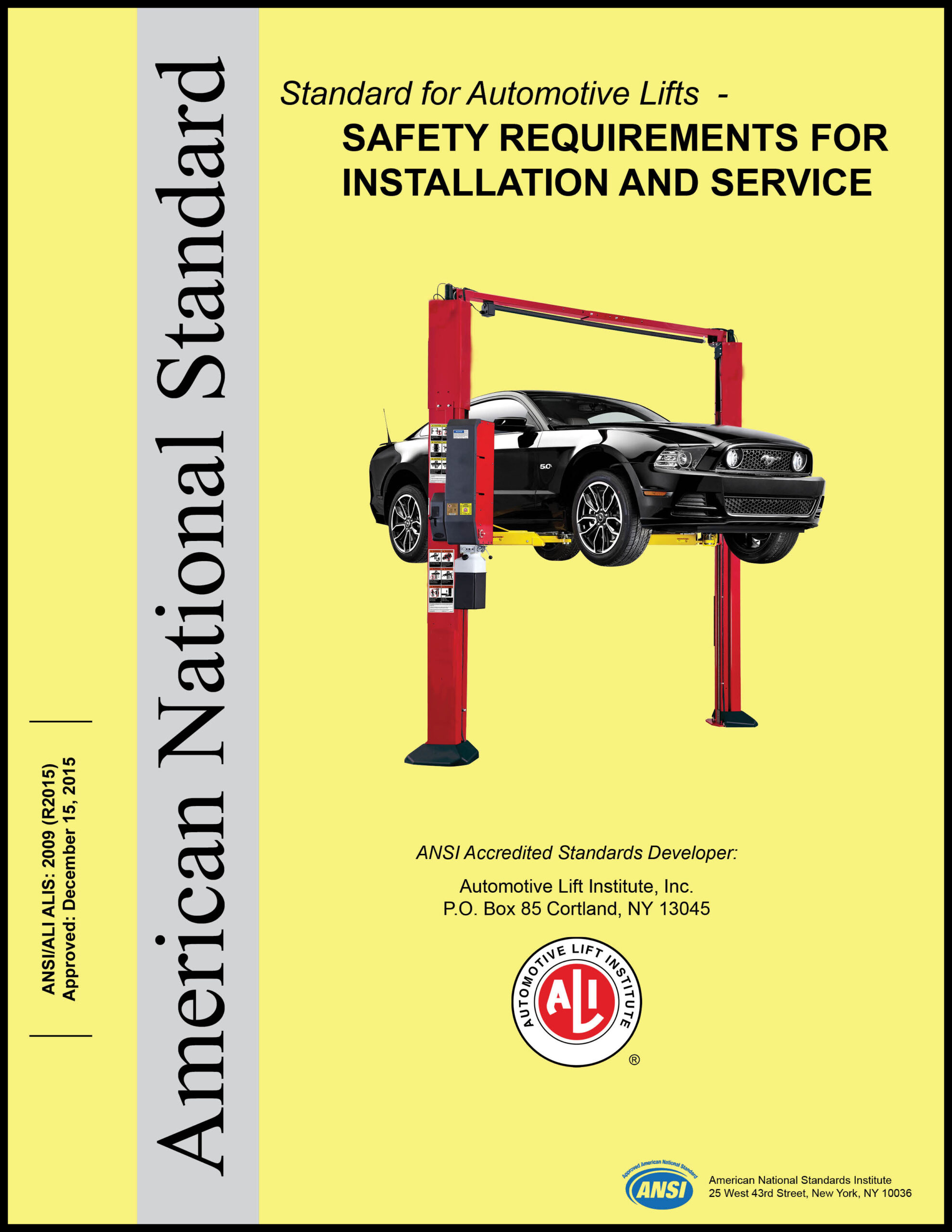
ALI launches an updated website
ALI launched a completely updated, mobile-friendly website. As part of the redesign, ALI brought management of the site and all directories in-house to enable real-time updates and ensure users had access to the most accurate, timely information. The site brought together information lift buyers, owners and users need, including:
The official directory of every ALI certified car, truck and vehicle lift, including certified accessories.
An exclusive directory of ALI Certified Lift Inspectors searchable by ZIP or postal code.
A list of leading North American lift manufacturers with website links.
Access to lift safety standards and materials, including online training.
Information on purchasing a lift, including FAQs, explanations of lift types and facts about codes and regulations affecting the purchase and installation of vehicle lifts across North America.
Buyer beware warnings about false or misleading lift certification and inspection claims.
ANSI/ALI ALIS: 2009 (R2015), Standard for Installation and Service becomes effective
The 2009 edition of the Standard for Automotive Lifts – Safety Requirements for Installation and Service was reaffirmed and continues to provide industry guidance on the issue of automotive lift installation and service.
ALI Relocates to New Facility
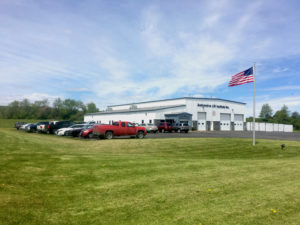 The Automotive Lift Institute (ALI) officially opened its new headquarters and LiftLab in Cortland, New York, on Oct. 12, 2017, with a grand opening celebration attended by ALI members, lift inspectors, suppliers and other guests from the vehicle lift and workplace safety industries. Growth of ALI lift safety initiatives like the ALI Lift Inspector Certification Program drove the need for a larger multipurpose facility.
The new 8,500-square-foot headquarters at 3699 Luker Road was more than four times larger than the organization’s previous Cortland office. It included 3,475 square feet of renovated office and conference space, as well as a modern classroom that complied with nationally recognized examination requirements for up to 20 participants.
What really differentiated the facility was its new LiftLab. ALI member manufacturers provided and installed 12 vehicle lifts in the expansive LiftLab area. They ranged from the smallest motorcycle lift to the most common two-post style, all the way up to heavy-duty inground and mobile column lifts. This was the only facility in North America that brings together such a wide range of operational lifts from various manufacturers and makes them available for hands-on industry training.
The Automotive Lift Institute (ALI) officially opened its new headquarters and LiftLab in Cortland, New York, on Oct. 12, 2017, with a grand opening celebration attended by ALI members, lift inspectors, suppliers and other guests from the vehicle lift and workplace safety industries. Growth of ALI lift safety initiatives like the ALI Lift Inspector Certification Program drove the need for a larger multipurpose facility.
The new 8,500-square-foot headquarters at 3699 Luker Road was more than four times larger than the organization’s previous Cortland office. It included 3,475 square feet of renovated office and conference space, as well as a modern classroom that complied with nationally recognized examination requirements for up to 20 participants.
What really differentiated the facility was its new LiftLab. ALI member manufacturers provided and installed 12 vehicle lifts in the expansive LiftLab area. They ranged from the smallest motorcycle lift to the most common two-post style, all the way up to heavy-duty inground and mobile column lifts. This was the only facility in North America that brings together such a wide range of operational lifts from various manufacturers and makes them available for hands-on industry training.ANSI/ALI ALCTV 2017 replaced the ALCTV – 2011 (New standard effective July 24, 2018)
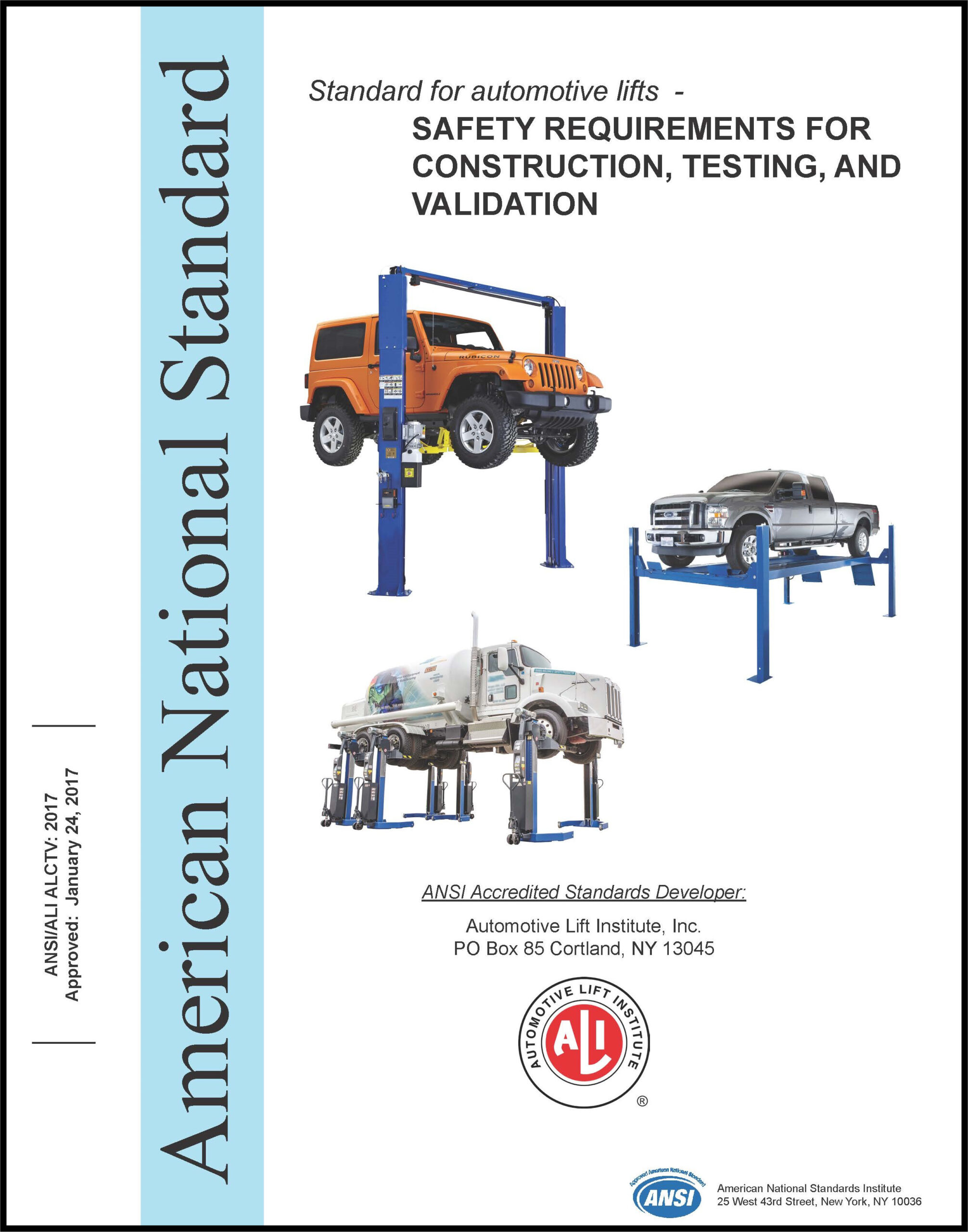 ANSI/ALI ALCTV is the safety standard covering vehicle lift design, construction, testing and validation. The current edition, ANSI/ALI ALCTV: 2017, took effect July 24, 2018, replacing its predecessor, ANSI/ALI ALCTV: 2011. While the major design and construction requirements of the standard remained intact, significant updates were made to strengthen the testing that must be performed by a Nationally Recognized Testing Laboratory to confirm that a lift meets these requirements. Changes included expanding the testing requirements for load-holding devices (also known as “latches” or “locks”) and increasing the number of test cycles.
ANSI/ALI ALCTV is the safety standard covering vehicle lift design, construction, testing and validation. The current edition, ANSI/ALI ALCTV: 2017, took effect July 24, 2018, replacing its predecessor, ANSI/ALI ALCTV: 2011. While the major design and construction requirements of the standard remained intact, significant updates were made to strengthen the testing that must be performed by a Nationally Recognized Testing Laboratory to confirm that a lift meets these requirements. Changes included expanding the testing requirements for load-holding devices (also known as “latches” or “locks”) and increasing the number of test cycles.Lou Santiago and ALI
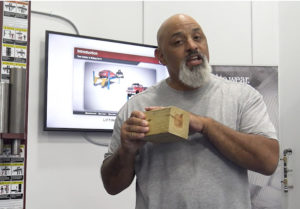 In the summer of 2018, ALI launched a four-part video series featuring celebrity car Lou Santiago. Watch the first episode here: https://youtu.be/qzgh_pr9fw4.
In the series, Santiago gives a behind-the-scenes tour of the new LiftLab facility at ALI’s headquarters in Cortland, New York. Along the way, he shares lift safety tips and highlights a couple of cool vehicles in the facility: a 1969 Plymouth Road Runner and a 1946 Brockway heavy-duty truck.
In the summer of 2018, ALI launched a four-part video series featuring celebrity car Lou Santiago. Watch the first episode here: https://youtu.be/qzgh_pr9fw4.
In the series, Santiago gives a behind-the-scenes tour of the new LiftLab facility at ALI’s headquarters in Cortland, New York. Along the way, he shares lift safety tips and highlights a couple of cool vehicles in the facility: a 1969 Plymouth Road Runner and a 1946 Brockway heavy-duty truck.ANSI/ALI ALCTV: 2017 Becomes Effective
ANSI/ALI ALCTV is the safety standard covering vehicle lift design, construction, testing and validation. The current edition, ANSI/ALI ALCTV: 2017, took effect July 24, 2018, replacing its predecessor, ANSI/ALI ALCTV: 2011. While the major design and construction requirements of the standard remain intact, significant updates were made to strengthen the testing that must be performed by a Nationally Recognized Testing Laboratory to confirm that a lift meets these requirements. Changes include expanding the testing requirements for load-holding devices (also known as “latches” or “locks”) and increasing the number of test cycles.
2018 International Building Code and Commentary Clearly Define Automotive Lift Safety Standards as a requirement within the IBC
“Except as otherwise provided for in this code, the design construction, installation, alteration, repair and maintenance of elevators and conveying systems and their components shall conform to ASME A17.1/CSA B44, ASME A17.7/CSA B444/7, ASME A 90.1, ASME B20.1, ANSI MH29.1, ALI ALCTV and ASCE 24 for construction in flood hazard areas established in Section 1612.3
IBC Commentary: The enforceability of a standard is established in this section and applies wherever the provisions of this chapter do not otherwise indicate a requirement. Therefore, even if a standard is not referenced anywhere else within this chapter it will be applicable to such systems and equipment. For example, automotive lifts are addressed by the reference to ANSI/ALI ALCTV but no further requirements are found in Chapter 30. This standard is fully applicable to such automotive lifts. Table 3001.3 contains specific referenced standards and indicates the type of elevator and conveying system components and equipment to which those standards are applicable.”
Lifting It Right Online Certificate Course – Offered as a Facility Subscription and in Spanish
In 2018, the 25th anniversary of Lifting It Right, ALI introduced an updated online course, including the first Spanish version. ALI also rolled out a new annual subscription option that allowed everyone at a single location to take the course as often as needed throughout the year.
ALI welcomed the first ALI Certified Inspector in Australia – Inspector #2127 from Precision Automotive Equipment!
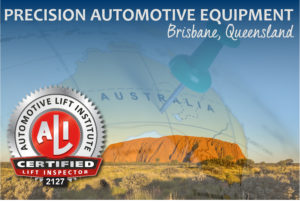
 ALI developed an oversized postcard to mail on behalf of ALI certified lift inspectors as an initiative that started with a first mailing in the fall of 2018. ALI committed to distributing approximately 23,000 to the dealers within the US and another 4,500 to the dealers throughout Canada.
ALI developed an oversized postcard to mail on behalf of ALI certified lift inspectors as an initiative that started with a first mailing in the fall of 2018. ALI committed to distributing approximately 23,000 to the dealers within the US and another 4,500 to the dealers throughout Canada.
The Lifting It Right: School Edition online course was introduced exclusively through S/P2.
https://www.autolift.org/wp-content/uploads/2020/07/SP2_ALI-Partner_releasead_sm-scaled.jpg
Protecting you for 75 years
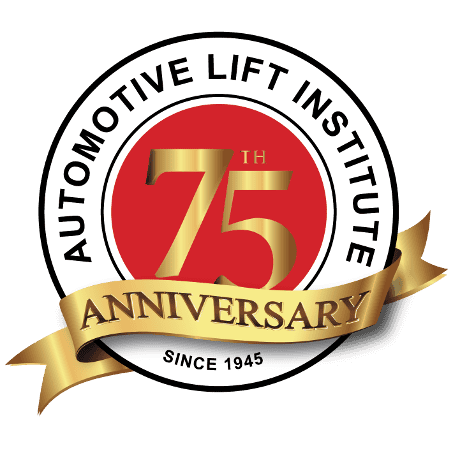 ALI celebrates its 75th anniversary as the lift safety watchdog in 2020. Today ALI has 20 manufacturer members, some 300 Associate members and 265 additional non-member lift manufacturer and inspection company participants. ALI sponsors three ANSI/ALI lift safety standards and two ANSI-accredited certification programs. The organization actively promotes lift safety and lift safety training to both experienced technicians and the technicians of the future through its educational outreach programs and Lifting It Right. Guided by its mission to promote the safe design, construction, installation, inspection and use of automotive lifts, ALI and its members have protected you for 75 years and will continue to faithfully watch over you into the future. After all, your safety is riding on it.
ALI celebrates its 75th anniversary as the lift safety watchdog in 2020. Today ALI has 20 manufacturer members, some 300 Associate members and 265 additional non-member lift manufacturer and inspection company participants. ALI sponsors three ANSI/ALI lift safety standards and two ANSI-accredited certification programs. The organization actively promotes lift safety and lift safety training to both experienced technicians and the technicians of the future through its educational outreach programs and Lifting It Right. Guided by its mission to promote the safe design, construction, installation, inspection and use of automotive lifts, ALI and its members have protected you for 75 years and will continue to faithfully watch over you into the future. After all, your safety is riding on it.ALI Expands Headquarters to include fully-equipped testing lab
